|
 Secure Site
Secure Site
|
 |
Archive for the 'Bamboo Chime Clocks' Category
 meditation increases compassion Maitryadisu balani
The cultivation of friendliness creates inner strength. (Yoga Sutra III.24)
We typically think of our emotional range as something that is fixed and unchanging—a reflection of the personality we’re born with. But research is revealing the possibility that we may be able to cultivate and increase our ability to feel the emotional state of compassion. Researchers have found that feeling connected to others is as learnable as any other skill. “We are trying to provide evidence that meditation can cultivate compassion, and that you can see the change in both the person’s behavior and the function of the brain,” Lutz says.
So what does compassion look like in the brain? To find out, Lutz and his colleagues compared two groups of -meditators—one group whose members were experienced in compassion meditation, and the other a group whose mambers were not—and gave them the same instructions: to generate a state of love and compassion by thinking about someone they care about, extend those feelings to others, and finally, to feel love and compassion without any specific object. As each of the participants meditated in-side the fMRI brain scanners, they were occasionally interrupted by spontaneous and unexpected human sounds—such as a baby cooing or a woman screaming—that might elicit feelings of care or concern.
All of the meditators showed emotional responses to the sounds. But the more experienced compassion meditators showed a larger brain response in areas important for processing physical sensations and for emotional responding, particularly to sounds of distress. The researchers also observed an increase in heart rate that corresponded to the brain changes. These findings suggest that the meditators were having a genuine empathic response and that the experienced meditators felt greater compassion. In other words, compassion meditation appears to make the brain more naturally open to a connection with others.
These meditation techniques may have benefits beyond the experience of spontaneous compassion. A study by psychology professor Barbara Fredrickson and her colleagues at the University of North Carolina, Chapel Hill, and the University of Michigan, found that a seven-week lovingkindness meditation course also increased the participants’ daily experience of joy, gratitude, and hope. The more participants meditated, the better they felt. Participants also reported a greater sense of self-acceptance, social support, purpose in life, and life satisfaction, while experiencing fewer symptoms of illness and depression. This study provides strong evidence that chipping away at the illusion of separation can open us up to a far more meaningful connection to life.
adapted from Yoga Journal by Kelly McGonigal
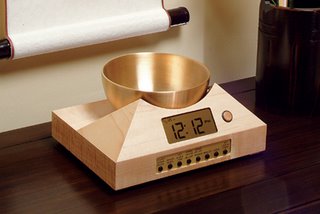 Zen Timepiece, a brass singing bowl clock and timer for meditation Now & Zen
743 Pine St.
Boulder, CO 80302
(800) 779-6383
Posted in Bamboo Chime Clocks, intention, Meditation Timers, mindfulness practice, Now & Zen Alarm Clocks, Well-being, Zen Timepiece by Now & Zen, Zen Timers
 mindfulness meditation Put it into Practice.
Mindfulness requires concentration, but rather than concentrate on any one object, we concentrate on the moment and whatever is present in that moment.
To begin, take a comfortable seat. Set your Zen Timer for 20 minutes. Bring attention to your breath by placing your awareness at your belly and feeling it rise and fall. This will help you tune in to the sensorial presence of the body. Once you
feel settled, widen your awareness to include all the sensations in your body as well as any thoughts or feelings.
Imagine yourself as a mountain. Some thoughts and feelings will be stormy, with thunder, lightning, and strong winds. Some will be like fog or dark, ominous clouds. Inhaling, note “mountain.” Exhaling, note “stable.” Use the breath to focus on the present moment; cultivate the ability to weather the storm. If you find yourself swept up in
a thought or emotion, notice it and simply return to the breath. The key is to pay attention to the ever-changing process of thinking rather than to the contents of your thoughts. As you begin to see that they are indeed just thoughts, they will begin to lose their power. You will no longer believe everything you think! Continue to watch and become mindful of your thoughts, feelings, and sensations for 5 to 20 minutes. Remember to set your Zen Timepiece to signal the end to this meditation.
adapted from Yoga Journal, by Kelly McGonigal
 Zen Timepiece, a meditation timer with bowl/gong Now & Zen
1638 Pearl Street
Boulder, CO 80302
(800) 779-6383
Posted in Bamboo Chime Clocks, intention, Meditation Timers, Meditation Tools, mindfulness practice, Now & Zen Alarm Clocks, Well-being, Zen Timepiece by Now & Zen, Zen Timers
 mediation and prayer Praying has a healing power.
A study by the Californian cardiologist Randolf Byrd helped inspire Larry Dossey to get involved in the healing power of prayer. In 1988 Byrd studied 393 heart patients. They were randomly divided into two groups using a double-blind technique, which means that neither the patients, nor the doctors or nurses knew to which group the patients belonged. Catholic and protestant prayer groups were given the names and health conditions of patients from the first control group and every day they directed their prayer to someone from that group. No prayers were said for the patients from the second control group. The group for which prayers were said needed five times fewer antibiotics than the other group, had three times less lung oedema and no one needed intubation to help them breathe, as opposed to 12 people in the other control group.
Larry Dossey has since become an authority in the area of ‘medicine at a distance’. He is more than convinced that prayer works: ‘Studies have irrefutably proven that people on a spiritual path – whereby meditation or prayer play a role – live an average of 7-13 years longer than those who are not. Moreover, cancer and heart disease are significantly less prevalent among those who pray or meditate. Prayer has an effect on nearly every living organism it has been tried on: people, various cells and tissue, animals, plants and organisms such as bacteria, fungi and yeast. At least 130 controlled laboratory experiments have been done.’
‘Prayer is communicating with the creative powers of the universe, with the extrasensory. There are different types of prayer: the appeal for something for yourself, the meditation in which you ask something for someone else, veneration, plea… In every case we go beyond our mind, which tends to think that it can solve everything by itself.’
Prayer to Dossey is not something holy that is only reserved to pious churchgoers: ‘Everyone can pray, even if you don’t believe in God. A friend of mine prays to “To whom it may concern”. Research clearly indicates that the intention of the prayer is important to the result. When you pray, do so with your whole heart, like a child, from a place of wonder, innocence and sincerity.’ One more tip: ‘There is not just one good way to pray. You can pray for something specific, give thanks or simply ask for help. When facing something difficult, for instance: “Come on God, help me out here.” It works! Try to find your own way to pray. If your wording becomes too formal, it often loses its power.’ Dossey remembers once sitting in a room during a lecture by a theologian. Someone asked: ‘How exactly should you pray?’ Her answer: ‘It’s very simple, ask God.’
 Dark Oak Zen Alarm Clock with Chime, a Meditation Timer Now & Zen
1638 Pearl Street
Boulder, CO 80302
(800) 779-6383
Posted in Bamboo Chime Clocks, Meditation Timers, Meditation Tools, mindfulness practice, Well-being, Zen Timepiece by Now & Zen, Zen Timers
 watsu
Watsu, a portmanteau of water and shiatsu, is a form of body massage performed while lying in warm water (around 35 °C or 95 °F). The receiver of Watsu treatment is continuously supported by the therapist while he or she rocks and gently stretches the body. Because it is performed in the water, the body is free to be manipulated and stretched in ways impossible while on the land. A normal session would a professional hour of 50 minutes. Many Watsu practitioners us the Zen Timer to end their sessions.
 Bamboo Digital Chime Clock, a Watsu Timer and Clock Watsu was created by therapist Harold Dull in the early 1980s, then director of the Harbin School of Shiatsu and Massage in northern California. The technique slowly evolved as he began to incorporate aspects of Zen Shiatsu into his therapy. Watsu pools have now been introduced as a therapeutic passive massage tool as in the 2008 Turkish hamams Lake Conroe resort project.
adapted from wikipedia.org
 watsu Now & Zen
1638 Pearl Street
Boulder, CO 80302
(800) 779-6383
Posted in Bamboo Chime Clocks, Chime Alarm Clocks, Hot Springs, Japanese Inspired Zen Clocks, mindfulness practice, Well-being
 - Well-being
Exhaustion Cause: Shallow Breathing
Breathing is our most elemental and immediate need. But there’s a big difference between breathing to survive and breathing to thrive. “Most people I meet take shallow, rapid breaths, using only about a third of their lung capacity,” says Weil. You need oxygen to metabolize your food so your body can produce energy. “Not breathing fully and efficiently has a huge effect on your vitality.”
Most of us don’t often stop to consider the way we breathe. “We don’t pay attention to it because we’re never taught to,” explains Weil.
Exhaustion Cure: Extend Your Exhalations
If you make a conscious effort to deepen your breathing, says Weil, “you’ll sleep better, gain more control over your moods, experience less fatigue, and have better energy overall.” Rather than start by taking a big, deep inhalation, increase your breathing efficiency with a focus on breathing out. “We have more voluntary control over the exhalation,” he explains. By learning to use the intercostal muscles (between the ribs) to expel more air from the lungs, “inhalation will automatically increase.”
For best results, Weil recommends spending a little time every day on breathwork. “Keep it very simple. For several minutes, simply squeeze at the end of every exhalation. You don’t have to sit in any special posture. You can do this anywhere, but lying in bed is a good place to start. Over time, your breath will become more regular, quieter, and deeper.” And your energy level will grow stronger. Remember to set your Zen Timer for a several minutes to remind yourself when to end your practice with a sweet chime sound.
adapted from Body + Soul, September 2009
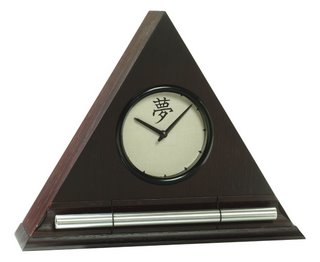 Dream Kanji Zen Alarm Clock with chime in Dark Oak Finish, a wellness tool for remembering dreams Now & Zen
1638 Pearl Street
Boulder, CO 80302
(800) 779-6383
Posted in Bamboo Chime Clocks
 zen-like garden, a perfect meditation space to use your Zen Meditation Timer A couple of years ago, I heard Diane Ackerman, who writes beautifully about gardens and gardening, discussing her passion on National Public Radio. She and the host agreed that our gardens reflect ourselves, our way of looking at life. I thought about my own garden, and I liked the idea. My lavender was just plumping with sweet-smelling buds, the vinca was fresh and green with perky purple flowers, and the peonies held promise in their tight little fists.
That was in June. By August, the thought of my wild, out-of-control garden reflecting anything about me was slightly horrifying. The lemon balm had run amok; the peony bush—never caged—was limp and trampled. In my backyard, a virulent type of Japanese knotweed had grown into a jungle. As it does every year, nature had taken its course in my yard, and I hadn’t managed to keep it in check. Oh, the temptation to just call it wabi-sabi and leave it at that. It was, after all, very natural in its untidy way.
But I know better. Wabi-sabi is tamed, subdued, and serene. I know that the natural gardens I inevitably fall for—which feel almost untouched by human hands—actually owe their serenity and peace to hours of hard labor. There’s a fine art to creating a garden that feels close to nature but also offers carefully thought-out spots for meditation and reflection, just the right combination of color and blooms throughout the season, and enough structure and muscle to provide interest even in December. One where I can use my Zen Timepiece to each day to do my mindfulness practice. A truly wabi-sabi garden is a creative endeavor of the highest sort. (And some day—when my kids are older and my work life slows down—I vow I’ll accomplish that.)
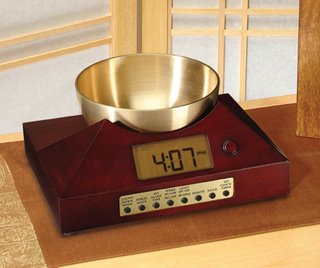 Zen Timepiece with brass singing bowl, a meditation timer I’m slowly working toward my wabi-sabi paradise by putting in plants that are native to my place: slightly weedy black-eyed Susans and columbine, wild rosebushes dug up from my neighbor’s yard, heat-loving yarrow. I’ve welcomed intruders, if they have something to offer and don’t get too pushy. The chokecherry that made its way down from the foothills near my house provides long, delicate white blossoms in springtime and brilliant red-orange leaves in the fall (great branches to bring inside). The mullein that planted itself in my flower garden is tough and phallic, but the bloom of tiny yellow flowers around its stalk in late summer expresses its feminine side.
These indigenous species, adapted to my brutal high-desert climate, can take care of themselves and manage to look good—even in August—without a lot of care and attention. The creative part, for me, is mapping out where they’ll thrive and how they’ll interact with each other and with the humans who visit. And this is where the wabi-sabi spirit really comes in. The wabi-sabi garden embraces and enhances the delicate balance between nature and nurture. It’s not formal and prissy like an English garden—but it’s not overrun with lemon balm and knotweed. Plants are chosen because they belong in that garden, in that climate. They’re allowed to strut their stuff, but they’re expected to be considerate of the plants around them—or be tamed. Brash, blowsy blooms, which generally require a high degree of maintenance, are used sparingly, if at all.
Just as important as what plants are chosen and where they’re placed are the garden’s bones: the stones and pebbles used to create winding paths and delineations, the rusty iron gate beckoning entrance, the trellis teasing vines up its length. In this aspect, gardens offer all sorts of wabi-sabi opportunity. Place an old, broken-down chair in the flowerbeds; let the weather work its magic and the plants grow up around it until it seems rooted and organic to that place. Plant gourds in an old wheelbarrow and let them spill languidly over the sides. Build a stone wall; the very act of placing stone upon stone is a satisfying meditation. Create paths that encourage guests to meander, with stopping points where the vista is ideal.
With the right structure in place, the wabi-sabi garden is as beautiful—if not more so—in December as it is in June. The sculptural bare branches, brittle seedpods, and somber palette of the winter garden are as wabi-sabi as it gets. Stark and naked, the plants stand as vivid symbols of nature’s way: birth, death, rebirth. The blossoms of life are easy to admire; the quiet integrity of plants gathering energy for rebirth takes a deeper appreciation. A stroll through the garden in the dead of winter is a fine place to cultivate that depth.
Adapted from Natural Home Magazine, March/April 2005 Reprinted with permission from The Wabi-Sabi House: The Japanese Art of Imperfect Beauty by Robyn Griggs Lawrence (Clarkson Potter, 2004).
Posted in Bamboo Chime Clocks, Chime Alarm Clocks, Japanese Inspired Zen Clocks, Now & Zen Alarm Clocks, wabi-sabi
 Sleep sounder with pure essential oils Studies indicate that certain aromas may promote sounder sleep, enhance dreaming, and improve awareness and receptivity the following day. EEG (electroencelphalogram) tests at the Smell & Taste Treatment and Research Center in Chicago indicate that lavender increases alpha wave activity in the posterior portion of the brain and helps induce sleep. “Alpha wave activity increases when you are relaxed,” says Alana Hirsch, M.D., medical director at the Center. “Put a few drops of lavender pure essential oils on your pillowcase before going to bed,” Hirsch recommends. Studies also show that vanilla helps people fall asleep quicker and promotes faster movement into the REM or dream state, he adds. In addition, research at the Society of Psychophysiological Research found that sleepers in jasmine-scented rooms enjoyed better quality sleep and morning-after alertness than those that slept in a non-scented room. To start sleeping sounder, purchase organic vanilla essential oil at your local natural food store or online at http://homespaorganics.com; pure essential oils of lavender and jasmine are also available at natural food stores and at www.aveda.com. Sweet dreams… adapted from Healing Lifestyles & Spas, Kyle Roderick, Sept./Oct. 2005
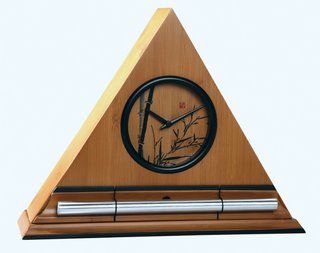 Bamboo Zen Alarm Clock with Chime Now & Zen
1638 Pearl Street
Boulder, CO 80302
(800) 779-6383
Posted in Bamboo Chime Clocks, Chime Alarm Clocks, Japanese Inspired Zen Clocks, Natural Awakening, Now & Zen Alarm Clocks, Sleep Habits, Well-being
 Irises by Ogata Korin Edo 1700s, Tokyo
Ogata Kōrin (1658 – 1716) was a Japanese painter and lacquerer.
 Zen Chime Alarm Clock, Digital Black Lacquer Chime Clock Now & Zen
1638 Pearl Street
Boulder, CO 80302
Posted in Bamboo Chime Clocks, Chime Alarm Clocks, Japanese Inspired Zen Clocks, Meditation Tools, mindfulness practice, Now & Zen Alarm Clocks, Progressive Awakening, Zen Timers
 Kiyonaga Torii, Beauties Listening to Bonsai Vendor Ukiyo-e Woodblock Print How can we save the world from growing intolerance, how can we stop the spiral of violence? ‘ Silence is often the best answer,’ says the Dalai Lama. More and more experts are admitting he is right. This is not the time for analyses, reports and threats. We now need to stop and take the time to really listen to one another. Of course, listening is not always easy, but a growing number of initiatives are aiming to help people master this difficult art. The International Listening Association declared March to be International Awareness Month.
As part of their campaign they gave tips on how to listen. ‘Count to three when the person you are speaking with has finished talking. That person will often take this to be a signal to go on talking. You will be surprised at how much extra information you get. If you are interrupted, do not get irritated, do not attack and do not lecture, but simply say: “Please listen for a moment, I am not finished yet.”
The American psychologist Michael Kahn wrote a book that includes the topic of listening: The Tao of Conversation (Rainbow Pockets, 1998). He describes people entering a conversation with the intention of winning, people that only feel better if the other person feels worse. ‘We so badly want to be heard and confirmed that we think it is worth having an argument. ‘ The listener is the one who is catching his breath after having presented his view.
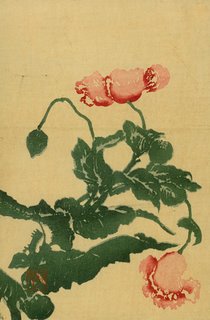 Peonies, c. 1900 unknown Kahn explains what a relief it was when he discovered a conversation does not have to be a contest. Like the Tao, it can flow calmly and peacefully and still be very powerful. Kahn’s tip: ‘Engage in a conversation as if you were making love to someone. Your good mood depends on how good the other feels. Or is your idea of a conversation a jam session, where musicians listen to each other and are inspired by each other? Ask yourself: Do I want to learn or do I want to win?’
Listening, true listening, heals. This was beautifully described years ago in Michael Ende’s classic Momo and the time savers. Because she is the only one in a hurried world who has time to really listen, the little vagabond girl Momo steals the hearts of all. Even children – taking after their parents – have less and less time for stories and games. In the end, Momo saves the city from the gloomy oppression of the grey men who are stealing everybody’s time. Listening as the solution to the world’s problems seems so simple, but in practice turns out to an enormous challenge. It is time we learned that history only repeats itself because nobody was listening the first time.
One of the ultimate Zen like experiences is waking-up from a great slumber refreshed and energized. Your mind and body are harmoniously one, both alert and focused. Having a refreshed mind and body are two keys to a natural and Zen lifestyle. Waking up in the morning should not be a loud and abrupt awakening, but rather it should be a peaceful positive experience. The right natural alarm clock can transition your deep and tranquil sleep into a serene start to consciousness. Imagine a long-resonating Tibetan bell-like chime waking you up to a beautiful morning experience.
The right alarm clock can be the most beneficial investment for you. With our Now & Zen natural alarm clock you are awakened more gradually and thus more naturally. Now & Zen is focused on creating a naturalistic lifestyle, and our clocks are an example of our philosophy.
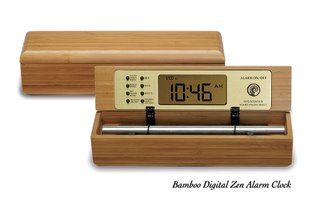 Bamboo Digital Chime Clock, a calming timer and alarm clock made from natural materials like bamboo, walnut, and maple adapted from Ode Magazine, April 2003 by Tijn Touber
Now & Zen’s Soothing Alarm Clock Store
1638 Pearl Street
Boulder, CO 80302
(800) 779-6383
Posted in Bamboo Chime Clocks, Chime Alarm Clocks, Goodness, Japanese Inspired Zen Clocks, Meditation Timers, Meditation Tools, mindfulness practice, Natural Awakening, Progressive Awakening, Truth, Well-being
 the beauty of imperfection Wabi and sabi refers to a mindful approach to everyday life. Over time their meanings overlapped and converged until they are unified into Wabi-sabi, the aesthetic defined as the beauty of things “imperfect, impermanent, and incomplete”.
Things in bud, or things in decay, as it were, are more evocative of wabi-sabi than things in full bloom because they suggest the transience of things. As things come and go, they show signs of their coming or going and these signs are considered to be beautiful.
In this, beauty is an altered state of consciousness and can be seen in the mundane and simple. The signatures of nature can be so subtle that it takes a quiet mind and a cultivated eye to discern them. In Zen philosophy there are seven aesthetic principles for achieving Wabi-Sabi.
Fukinsei: asymmetry, irregularity
Kanso: simplicity
Koko: basic, weathered
Shizen: without pretense, natural
Yugen: subtly profound grace, not obvious
Datsuzoku: unbounded by convention, free
Seijaku: tranquility
Each of these things are found in nature but can suggest virtues of human character and appropriateness of behaviour. This, in turn suggests that virtue and civility can be instilled through an appreciation of, and practice in, the arts. Hence, aesthetic ideals have an ethical connotation and pervades much of the Japanese culture.
adapted from wikipedia.org
 Zen Alarm Clock, Ukiyo-e Hokusai Wave Dial Face Now & Zen Headquarter Store
1638 Pearl Street
Boulder, CO 80302
(800) 779-6383
Posted in Bamboo Chime Clocks, Chime Alarm Clocks, Hokusai Wave, Japanese Inspired Zen Clocks, mindfulness practice, Natural Awakening, Now & Zen Alarm Clocks, Progressive Awakening, wabi-sabi
« Previous Entries
Next Page »
|
|
|
|